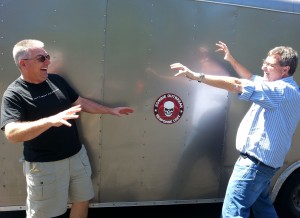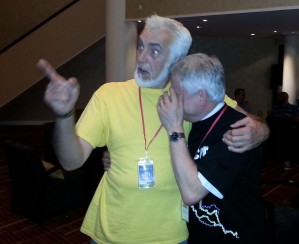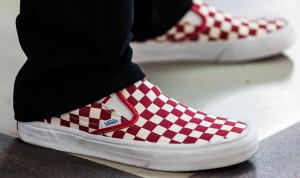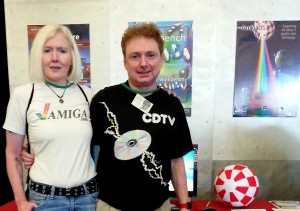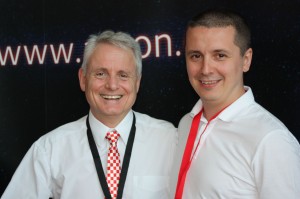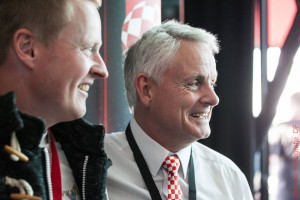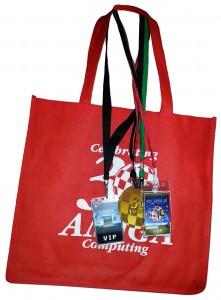
After my trip to the Amiga30th in Amsterdam last month and my subsequent visits to California and the UK to attend two more Amiga30th Anniversary events, I’m now safely back in New Zealand. I have just about overcome the triple-whammy of three time zones, jet-lag and late nights coupled with a slight over-indulgence of alcohol. 😉 The shows at the Computer History Museum in Mountain View, California and the Amiga30th Charity event in Peterborough in UK were two very different gatherings but, like the Amsterdam Amiga30 show, were bound by a common theme – the coming together of true Amigans to celebrate the Amiga’s 30th Anniversary. In each case the events were backed by a lead organizer(s) and a supporting team, and despite some minor teething problems, they all somehow managed to deliver three very successful and enjoyable Amiga shows.
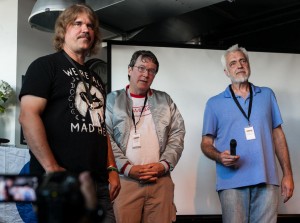
Amsterdam Amiga30th: A Dutch treat – was organized by the incomparable hosts, Marcel and Marvin. They somehow managed to cram almost 450 people into the tiny Lighthouse venue although there was also a separate marquee for all the Amiga exhibits and displays. The Dutch weather was kind and the after-show VIP canal cruise was very special.
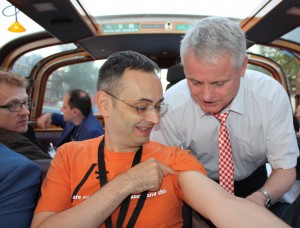
Apart from the joint performance of the 3 Amigos (RJ Mical, Carl Sassenrath and Dave Haynie), the other highlight for me was walking the streets of Amsterdam at 4:30 am on Sunday morning with Marcel, Marvin, Dave Haynie and Matthew. My only disappointment was not getting a signed copy of Petro Tyschtschenko’s book.
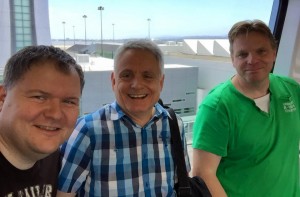
When I finally managed to get some free time to visit the marquee display area he had already left. Hopefully I will be able to get a copy of his book at the Neuss Amiga30th event in Germany in October. Hey who said I don’t read German? OK it’s true but at least I can look at the pictures. Having organised the Amsterdam show, Marcel and Mavin caught the Amiga30th bug and attended both the California and UK events.
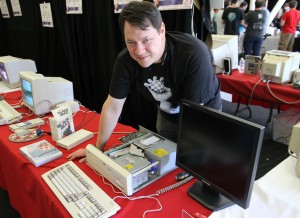
Computer History Museum, Mountain View, California: A family affair – Bill Borsari aided by a team of organisers and volunteers which included such Amiga luminaries as Dale Luck, Carl Sassenrath, Dave Needle, Sam Dicker and many, many others put on the most ambitious 30th Anniversary event in the spiritual home of the Amiga computer. What can I say about this show? I met so many of the original Amiga family it felt that we had gatecrashed their special Amiga, Inc reunion party.
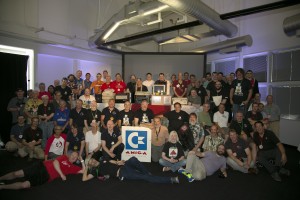
Almost the entire team was present, apart from the few people like Jay Miner and Dave Morse who, sadly, are no longer with us. I had the privileged of mixing and talking with many of the original Hi-Toro team including Don Ressinger, Amiga marketing & sales and even Bill Hart, the original Amiga Corp VC. It was very moving to see the special bond that still exists between these people after all these years. Many former Commodore employees were also present, including Colin Proudfoot, the joint MD of Commodore UK who now lives in California. Their combined presence added to the overall feel-good factor at the show. And of course there was the premier of Zach Weddington’s Viva Amiga movie which was shown to the banquet audience. I sat at a table with many of the original Hi-Toro/Amiga founders and staff and there was barely a dry eye at the table as the movie played. It was all very emotional.
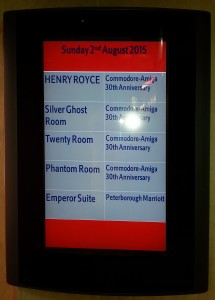
Peterborough VIP Charity Dinner: For the common good – The brain child of Steve Crietzman and his team of volunteers (plus his dad) which combined the UK Amiga30th party with a VIP charity dinner to raise money for the BBC “Children in Need” charity appeal.

The event also highlighted the special effect the UK games industry had on the Amiga and included luminaries such as Tim Wright (aka CoLD SToRAGE), Allister Brimble, Mike Clarke, Andrew Barnabas, Jon Hare and Bjørn Lynne who represented the combined talents of Team 17, Bitmaps Brothers, Sensible Software and Pygnosis. The presence of former the Commodore UK joint MD David Pleasance and the irrepressible RJ Mical added to the overall vibe of the event. The show was a great success and Steve raised a lot of money for charity with a raffle and excellent after dinner auction. Unbelievably, I won a Boing Ball beach ball in the raffle. Even I shouted out “fix”. 😉 Oh, and I bought a CDTV T-Shirt in the charity auction.

Each Amiga30th show had it’s own very distinctive theme and flavour and I felt really privileged to be able to attend and sponsor all of the celebrations and show that Next-generation AmigaOS systems are still being developed and sold. Although I was a little dismayed to find out I am actually 2 years older that RJ Mical. 😉
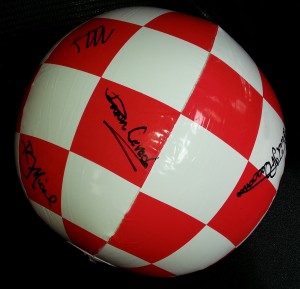
To see ourselves as others see us! (DirectX and the Amiga)
I have mentioned in an earlier blog that in my in role as a business angel I get to see a lot of cool technology and ideas. Well the other day while looking at another impressive young startup I had the pleasure of meeting Alex St. John, one of the creators of DirectX, the skunk-work project at Microsoft which was incorporated into Windows95. What really surprised me was that, according to Alex, it was his Amiga lineage which had a real influence on the DirectX development. On hearing this I almost forgot the reason for the meeting and we were soon talking animatedly about the good old Amiga days. I asked him if he could provide some information for my Amiga blog and this is what he sent me:
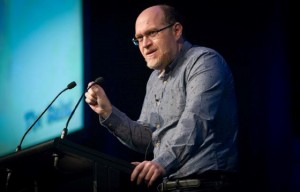
“I started programming when I was quite young (11) on the University of Alaska Honeywell mainframe. My first and most beloved computer was the Commodore Vic-20 which I got when I was around 13. I immediately took to making games for myself on it. My first game was a game I called Dungeoneer which involved a dot running around a line maze fighting red dot monsters and avoiding X traps. It was practically World of Warcraft to me back then. By the time the Commodore Amiga arrived in 1987 I was a hopeless Commodore fan. I couldn’t wait to get one.
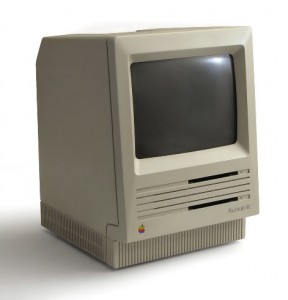
It was one of the most remarkable computers ever made.
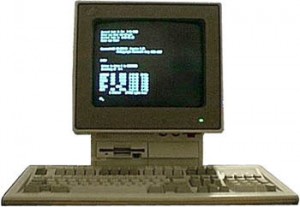
A multitasking consumer OS running hardware accelerated audio, sprite graphics, and displaying thousands of colors in an era when PC screens were green and a state of the art Apple Macintosh looked like this;
This was what Amiga graphics looked like back then! And unlike the game consoles of that era, I could program the Amiga!
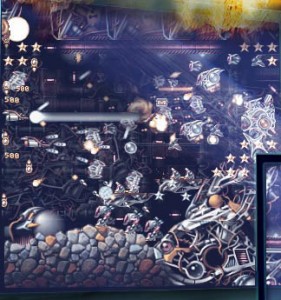
As a kid who loved writing and playing Commodore-64 games, the Amiga was a dream come true. I had never dreamed of having access to program such amazing media features. You could make games that were better than anything the leading edge game consoles of that era could match. Exposure to the Amiga early in my career turned out to be a pivotal influence later on as I moved on to learning 3D graphics. Tragically Commodore with its unequivocally superior product and technology for that era managed to go out of business in 1994. The same year myself and a couple friends began developing the DirectX media architecture at Microsoft…
At the time that I joined Microsoft Windows supported 8bit color displays and had no hardware support for accelerated sound or video. A windows media file in that era used a fixed 8bit color palette to display an entire video of any length. If you watched a video of more than a minute in length the audio would drift out of synchronization with the imagery until it was like watching a bad English dubbing job of a German movie. I had been given the job of helping hundreds of DOS game developers migrate their DOS games to the forthcoming Windows 95, which was only marginally better at graphics. I secretly seethed at the idea that Microsoft was going to ship a new state of the art multi-tasking OS in 1995 that was inferior to a 1987 Commodore Amiga. My two nerd friends and I from Microsoft’s Windows 95 evangelism team conspired to introduce Amiga like media capabilities to the PC platform.
We designed the early DirectX media API’s. DirectSound which enabled real-time hardware mixing of dozens of hardware accelerated audio channels. DirectDraw which enabled Amiga like video hardware accelerated sprite animation, DirectInput which enabled digital game pads on the PC for the first time, DirectVideo to enable hardware accelerated 24bit color video with proper audio synchronization and DirectPlay to enable the first real-time Windows based multiplayer games. It was too late to ship the technology with Windows 1995 so I persuaded the hundreds of DOS game developers I was working with to adopt it and ship the first DirectX libraries with their first Windows games. Because Windows 95 couldn’t support the new DirectX capabilities, we modified Windows 95 to enable us to disable most of the OS when a DirectX game was running thereby creating the illusion for the consumer that it could really run such games. A year later we designed and shipped Direct3D and Amiga lived again in Windows 95!

SuperBubsy was the first hardware accelerated, sprite animated DirectX demo running at 500fps at 640×480 in 16bit color in Windows 95. ATI (Now AMD) supported the very early efforts to enable Amiga like graphics in Windows by porting games like SuperBubsy to the early DirectX API’s.
At the time it was a huge deal, Windows 95 became the most popular and widely adopted consumer OS Microsoft had ever made and Apple’s market share collapsed through 1997 as PC’s enabled with Amiga like audio and graphics accelerators swept the consumer market. Nolan Bushnell (Atari’s Founder) came to visit us at Microsoft and said told us HE was OUR fan. We did the deal with Sega a year later to port DirectX to the next generation Sega Dreamcast but when Sega failed, Gates decided he wanted to make a console of his own. Today the Xbox or the “DirectXBox” as I knew it is the direct descendant of that early attempt to return amazing Amiga like media capabilities to consumer computing. DirectX, which was bolted on to Windows 95 is now the underlying OS architecture for all Windows media and graphics. 20 years later I’m sitting in my garage office programming away in CUDA on a 5 Teraflop GPU from Nvidia that evolved from the early success of DirectX and the timeless influence of the Amiga OS on computing. More importantly, DirectX is the reason a Windows PC can run an AmigaOS emulator today.”
I suppose Alex’s story should come as no real surprise. During the Amiga30th events people regularly approached one or more of the Amiga founders and thanked them for creating the Amiga and influencing their career paths. Who said, “only Amiga makes it possible?” 😉 Oh, and did I invest in Alex’s new startup? What do you think? 🙂
Elastic Reality
It was not only former Commodore and Amiga people who visited the Californian Amiga30th show. Several major Amiga 3rd-party hardware and software developers also turned up to help celebrate the Amiga’s 30th birthday.
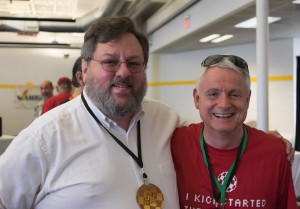
This included Amiga artist Leo Schwab, complete with his trademark ruffled shirt, hat and cape and Video Toaster God, Tim Jenison who, unfortunately, I did not get to speak to. However, I did managed to catch up with ASDG founder Perry Kivolowitz who was a fellow presenter at the event. I managed to watch Perry’s presentation in which he talked about his Amiga history and after the first 10 minutes, I realised I could have written his speech myself! In fact, in many ways I already had :-).
If you are a reader of Amiga Future magazine you may know that I write the Classic Reflections series in which I review the contributions a person or company had on the Amiga scene.
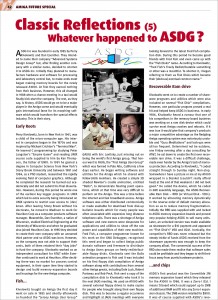
In issue 97 of Amiga Future I wrote about ASDG, and as luck would have it, I had a copy of the article text on my laptop. So, after Perry finished his presentation I approached him and suggested I could have been his speech writer and, with some trepidation, showed him the first page of my ASDG article. This is the first time I’ve ever shown one of my articles to an actual subject. Fortunately, I’m happy to say he was both surprised and pleased with what I written. He even said “I don’t know why I bothered to prepare a speech, I could have just read out your article!” Anyway, I provided him with a copy of the full text and promised to send him the complete article with photos when I returned to New Zealand. He in turn promised to read through the article and correct any mistakes he found. The good news is Perry has now sent me his (small ;-)) list of corrections/comments and has promised to provide me with and interview and more in-depth information for an ASDG reprise article. Look out for this update in a future edition of Amiga Future magazine.
You can now be Cyrus – version 2.2!
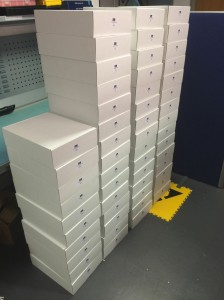
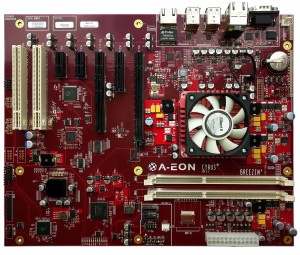
With the release of the AmigaOne X5000 fast approaching, our manufacturers have started shipping the Cyrus+ production motherboards to our supplier. The production board is designated version 2.2 and is equipped with a silent CPU cooling fan and improved CPU fan control firmware. A new “Boing Ball” case design is also being released for the AmigaOne X5000 system.
My backyard is bigger than yours!
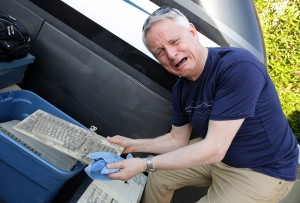
While helping to prepare for the Amiga30th at the Computer History Museum I got roped into volunteered to help prepare some of the exhibits for the Amiga history display. 😉 This involved working in Dale Luck’s yard/workshop helping to clean monitors, computers and keyboards in preparation for the show. (A note to all Amiga collectors out there, someone has always got a bigger collection than you!) Dale’s collection is not just impressive, it’s mind boggling.
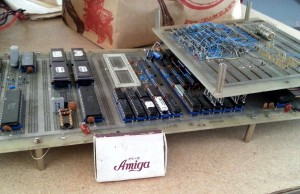
At every turn there is another piece of Amiga memorabilia and history. Whether its parts of Lorraine, “War & Peace”, an SX-500 or a A500 based arcade game machine there are amazing pieces of unique Amiga hardware everywhere you look.
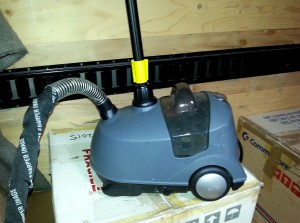
Of course Dale has worked for many other companies and also has a particular fondness for arcade machines and these can be found all over his property.
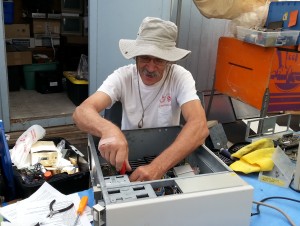
However the real hero of the piece was SACC’s Dan Kloczko who had spent weeks sleeping out at Dale’s place helping to prepare all of the machines for the Amiga30th show.
Linux Corner
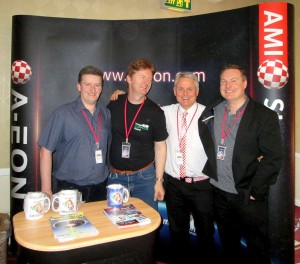
Darren Stevens and Pat Wall, two active members of our Core Linux support team attended the Amiga30th Charity event in Peterborough. Pat flew in from Eire while Darren managed to squeeze the show in between his work commitments. Pat is our distro guru and is the talent behind our Live Ubuntu Remix distribution while Darren is one or our Linux Kernel experts making sure that our hardware supports the latest kernel updates. Meanwhile, fellow kernel specialist Christian Zigotzky and new Linux team member Julian Margetson continue to fine tune our “special projects” Linux distribution. More on this later. 😉
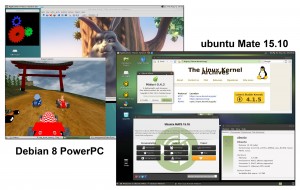
And if that is not enough Christian has just released the Linux 4.2-rc7 Kernel for testing. All indication are if this goes well Linus Torvalds will be issuing the full 4.2 kernel within the next week or so. Our team continue to support many PowerPC Linux distributions and are forging close working relationships with many of the PowerPC support groups.
You know you’re getting old when…..
Part 1……..I was helping to set up all the Amiga computers for the Amiga family group shot at the end of the California show.
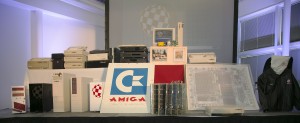
This entailed carrying all of the computers from the Amiga history area to the stage in the main lecture hall. I had already carried a couple of smaller machines and decided to pick up an Amiga 3000T which has got to be the heaviest Amiga on the planet. I knew this already as I have an A3000 tower in my own collection but I was taken aback when I first attempted to pick up the machine. Yes, they are very heavy. Honest! As I looked at the A3000T and mentally prepared myself for the second attempt to pick it up, former Commodore engineer (and SACC member) Beth Richards offered to carry it to the stage for me. She was surprised when I refused her gracious offer and manfully picked up the A3000T and struggled with the machine to the staging area. To the greate amusement of my fellow (male) volunteers, AmigaOS Team Lead, Steve Solie starting whistling the tune to the American sitcom Two and a half men which goes something like, “Men men men men, manly men, oo hoo hoo, hoo hoo, oo!”
Part 2…….. After the California show I travelled to the UK to attend the Amiga30th Charity event in Peterborough. I arrived at Heathrow airport after the overnight transatlantic flight feeling a little disheveled and took the tube to central London. I changed at Green Park station to pick up to the Victoria line and, with case and bag in hand, looked up at the long flight of stairs which would take me to the correct platform. A young man in running shorts who had obviously been exercising took one look at me and offered to carry my case up the stairs! All I need now is for a teenager to offer to give up their seat to me on a bus and I know it’s all over! 😉
….and finally
Favourite phrase used at all the Amiga30th shows, “What happens at the Amiga 30th, stays at the Amiga30th!”.
